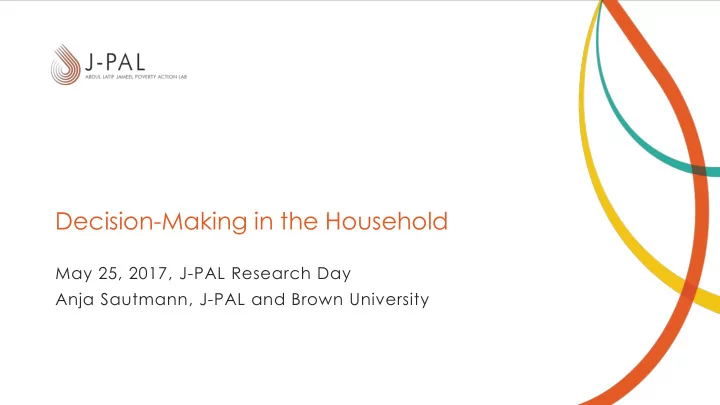

Decision-Making in the Household May 25, 2017, J-PAL Research Day Anja Sautmann, J-PAL and Brown University
Decision-Making Questions DHS: “Who makes decision about x?” • Example: health – Participant survey: • “vague, too broad, unclear what they measure” – Broad categories mask heterogeneity in degree of involvement and – “subcategories” e.g. what type of health decisions Validation exercises by several participants – Anja: some thoughts on the theory on HH decision making • Alessandra: • Markus: •
Decision-Making in the Household • Spheres of empowerment: • Within public life – (male) figures of authority (employer, law enforcement, teacher), criminal perpetrators, harassers • Within the household – (male) family members and cohabitants • Types of decisions • Important life decisions: education, labor force participation, marriage, fertility • Day-to-day, repeated activities and consumption • Bargaining models: • How are groups sharing (utility) surplus that is not allocated through the market?
Decision-Making in the Household • Spheres of empowerment: • Within public life – (male) figures of authority (employer, law enforcement, teacher), criminal perpetrators, harassers • Within the household – (male) family members and cohabitants • Types of decisions • Important life decisions: education, labor force participation, marriage, fertility • Day-to-day, repeated activities and consumption • Bargaining models: • How are groups sharing (utility) surplus that is not allocated through the market?
Allocation in the Household Man Woman
Allocation in the Household Threat point woman Threatpoint: e.g. divorce • Man Threat point man Woman
Allocation in the Household Threat point woman Threatpoint: e.g. divorce • Man Axiomatized bargaining • E solutions: point on utility frontier Pareto weight θ determines location • on utility frontier (in maximization of weighted utilities) Threat point man Woman
Allocation in the Household Threat point woman Threatpoint: e.g. divorce • Man Axiomatized bargaining • E N solutions: point on utility frontier Pareto weight θ determines location • on utility frontier (in maximization of weighted utilities) Threat point man Nash: Rubinstein bargaining • Woman
Allocation in the Household Threat point woman Threatpoint: e.g. divorce • Man Axiomatized bargaining • E solutions: point on utility frontier N K Pareto weight θ determines location • on utility frontier (in maximization of weighted utilities) Threat point man Nash: Rubinstein bargaining • Woman
”Structural” vs. intra -household inequality Structural inequality = threat point • Legal framework, job opportunities, option of living alone – Each may be correlated with – Demographics (age, education) • Who earns the income (labor market value) • Gender • Bargaining = split ”after market” • Browning-Chiappori : “distribution factors” can shift θ , e.g. – Demographics (age, education) • Who earns the income (labor market value) • Gender •
”Structural” vs. intra -household inequality What do we want to measure? • Probably NOT structural inequality: – Not likely affected by interventions in the short term/within the same household • Better measured directly • Bargaining power: want to look at – Decisions about ‘ non-market surplus ’ – uncorrelated with threatpoint • Potential for conflict/rivalry – private consumption or differently valued public • goods Cooperative/full information decisions • Relative change of total utility/happiness – ‘ compensated change’, or pre -/post • differences in specific (validated) goods Possibly: de-facto allocation determinants: e.g. psychosocial power imbalance • Emergence of conflict in re-negotiation process(?) •
Allocation in the Household Threat point woman Man before Can we measure change in the slope of the utility frontier? after Threat point man Woman
Discussion What is the group’s experience with decision -making questions? • Which questions respond to interventions, and how? – What’s their variability? – Based on reported findings: suggestions for improvements on these • questions? Validation exercises that should be done before using? What is these questions’ independent value compared to other • measures of intra-household bargaining, e.g. outcomes (health, education e.g. of children … ), and structural determinants of inequality?
Recommend
More recommend